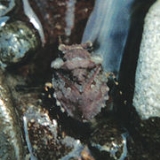
Gelastocoridae
Encyclopedia
The Gelastocoridae is a family of about 100 species of insect
s in the suborder Heteroptera
. They are reminiscent of toad
s both in the warty appearance and hopping movements of some species.
is in the tropics
.
Nymph
s of many species cover themselves with a layer of sand grains. Apart from the no doubt considerable physical protection that the armour affords them, the layer of sand renders them effectively invisible on the ground unless they move at the wrong moment.
, they have hemelytra
for their forewings and piercing-sucking mouthparts
. Their antennae
are hidden.
Insect
Insects are a class of living creatures within the arthropods that have a chitinous exoskeleton, a three-part body , three pairs of jointed legs, compound eyes, and two antennae...
s in the suborder Heteroptera
Heteroptera
Heteroptera is a group of about 40,000 species of insects in the Hemiptera. Sometimes called "true bugs", that name more commonly refers to Hemiptera as a whole, and "typical bugs" might be used as a more unequivocal alternative since among the Hemiptera the heteropterans are most consistently and...
. They are reminiscent of toad
Toad
A toad is any of a number of species of amphibians in the order Anura characterized by dry, leathery skin , short legs, and snoat-like parotoid glands...
s both in the warty appearance and hopping movements of some species.
Biology
Gelastocoridae are riparian insects, generally found at the margins of streams and ponds, where they are predators of small insects. Gelastocoridae catch their prey by leaping on top of them and grasping them with their modified front legs. Members of the family are found throughout the world, but their highest diversityBiodiversity
Biodiversity is the degree of variation of life forms within a given ecosystem, biome, or an entire planet. Biodiversity is a measure of the health of ecosystems. Biodiversity is in part a function of climate. In terrestrial habitats, tropical regions are typically rich whereas polar regions...
is in the tropics
Tropics
The tropics is a region of the Earth surrounding the Equator. It is limited in latitude by the Tropic of Cancer in the northern hemisphere at approximately N and the Tropic of Capricorn in the southern hemisphere at S; these latitudes correspond to the axial tilt of the Earth...
.
Nymph
Nymph
A nymph in Greek mythology is a female minor nature deity typically associated with a particular location or landform. Different from gods, nymphs are generally regarded as divine spirits who animate nature, and are usually depicted as beautiful, young nubile maidens who love to dance and sing;...
s of many species cover themselves with a layer of sand grains. Apart from the no doubt considerable physical protection that the armour affords them, the layer of sand renders them effectively invisible on the ground unless they move at the wrong moment.
Diagnostic Characteristics
Gelastocoridae are short (6-15mm long) and stout, with large protuberant eyes and cryptic coloration. Like other HeteropteraHeteroptera
Heteroptera is a group of about 40,000 species of insects in the Hemiptera. Sometimes called "true bugs", that name more commonly refers to Hemiptera as a whole, and "typical bugs" might be used as a more unequivocal alternative since among the Hemiptera the heteropterans are most consistently and...
, they have hemelytra
Insect wing
Insects are the only group of invertebrates known to have evolved flight. Insects possess some remarkable flight characteristics and abilities, still far superior to attempts by humans to replicate their capabilities. Even our understanding of the aerodynamics of flexible, flapping wings and how...
for their forewings and piercing-sucking mouthparts
Insect mouthparts
Insects exhibit a range of mouthparts, adapted to particular modes of feeding. The earliest insects had chewing mouthparts...
. Their antennae
Antenna (biology)
Antennae in biology have historically been paired appendages used for sensing in arthropods. More recently, the term has also been applied to cilium structures present in most cell types of eukaryotes....
are hidden.

